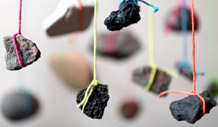
By Isabel Pina Ferreira and Lizzy Burt
Dance performance depicts link between rocks and the body
A special performance by a dancer at the University of Exeter’s picturesque campus is one of the events on offer as part of a project examining the links between the human body and the geological world.
The free and public exhibition also includes video installations and pictures by British and overseas artists depicting ways in which the human body encounters and connects with rock. The exhibition is designed to raise questions about people’s place in the world and their responsibility towards the environment.
The project, Rock/Body, involves humanities scholars, social scientists, and earth scientists working alongside visual and performing artists.
Researchers are meeting at seminars throughout 2016, including at the British Geological Survey in Nottingham, to examine the intersections of minerals and flesh, and parallels between geological extraction and human exhaustion under capitalism.
They will also investigate how performance art might be able to connect bodies of artists and audiences to the rhythms of the geological world.
The dance is one of two collaborative performance works devised especially for the project, and for the University of Exeter’s Streatham campus, a registered botanical garden. Carolyn Deby and Annette Arlander will explore the slow pace of geological change, and German choreographer Paula Kramer will devise a new dance piece responding to its location and to David A. Paton’s work with granite.
Videos on display include a durational performance for camera by artist Annette Arlander filmed by Lake Kilpis in Finland, and a medium-length film shot in the Antarctica by artist duo VestAndPage
Also on show will be photographs and drawings by artist Rose Ferraby exploring intersections of geology and culture in the Jurassic Coast, and two short videos by David A. Paton on the rhythms and poetics of a Cornish granite quarry.
Visitors can also learn more about the role of copper in our lives through “weheartcopperheartus” a web-based project and research archive by Mirko Nikolic. Copper is used as a fundamental conductor of power and data today. It is also present in the human body. The project records and tracks the different meanderings of that important metal in the contemporary world.
Dr João Florêncio, who is leading the project and curated the exhibition, said: “At first glance, rock and flesh seem like disparate realms with little in common. But as this exhibition highlights, geologic and human bodies are porous to each other and mutually implicated in many ways.
“Calcium is essential for bones and teeth, we have depended on coal and oil for warmth and industry and now metals like copper form an essential part of the new gadgets we depend on in our day-to-day lives. At the same time, human bodies, supported by bones made of calcium and aided by technologies made of metal, provide their labour to the industries that find and mine those resources.
“This is an exciting exhibition which will draw attention to our implication in our environment whilst also showcasing our beautiful university campus.”
The exhibition will be held at the Thornlea building on New North Road on September 8 and 9, from 10am to 6pm.
To attend the performances members of the public should meet outside the Thornlea building at 5pm on September 9.
Discover more at the event’s Facebook page, Twitter account or website.
Date: 4 August 2016
